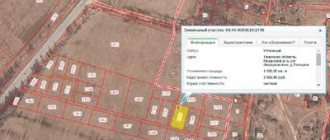Land owners quite often carry out various manipulations with them. One of the most common procedures is the alienation of a land plot.
It can be carried out on the owner’s own initiative or under duress. Alienation of plots is required not only during purchase and sale, but also in the case of providing the territory for lease.
- 1 What is it
- 2 Law
- 3 Varieties
- 4 Criteria
- 5 Alienation procedure
- 6 Stages
- 7 Share of land
The alienation procedure must be carried out in accordance with all legal norms. Only in this case does it have legal force and cannot be challenged.
What it is
The alienation process is the transfer of ownership of a privately owned land plot from one owner to another. Simply put, it is a transfer of ownership.
ATTENTION! Land is a type of real estate that each owner can dispose of at his own discretion.
It can be given, sold, bequeathed, or rented out. Those types of transactions in which the right of ownership is not transferred are not considered alienation. For example, renting. Alienation is carried out for several reasons:
- Transactions carried out at the initiative and voluntary consent of the owner (donation, will, sale, exchange).
- Forcible alienation by court decision.
- In accordance with administrative acts.
When carrying out the procedure, it is necessary to remember that there is a territory that, according to the law, is not subject to alienation. This is the territory of protected areas, nature reserves, national parks, etc.
Forced alienation of property by right of ownership
At the same time, the Civil Code of the Russian Federation contains norms according to which the alienation of property is not always a decision made by the subject of law independently and of his own free will.
Thus, the owner of property that, by virtue of the law, cannot belong to him (for example, if the alienated property is an item related to objects whose circulation is limited, clause 2 of Article 129 of the Civil Code of the Russian Federation), must alienate it within the time limits established by law (Article 238 of the Civil Code of the Russian Federation).
Another situation is when real estate objects located on a land plot seized due to improper use are sold at auction (Article 239 of the Civil Code of the Russian Federation).
Another example is the alienation of property associated with the imposition of a penalty on it. For example, foreclosure on housing that is the subject of a mortgage (Clause 1, Article 50, Articles 51, 55 of the Law “On Mortgage (Pledge of Real Estate)” dated July 16, 1998 No. 102-FZ).
Conclusion! Thus, these actions are performed by the copyright holder himself, albeit in accordance with the mandatory requirements contained in the law.
Law
The alienation of land is carried out in accordance with the requirements and norms specified in the legislation.
ATTENTION! This procedure is regulated by articles 44 and 52 of the Land Code, as well as chapter 27 of the Civil Code.
If during the alienation at least one point is violated, the procedure can easily be declared invalid and challenged in court:
- the transaction is carried out at the initiative and desire of the owner, on the basis of a purchase and sale agreement, donation, or a valid will. According to these papers, the right to own a land plot passes from one person to another;
- in the case of forced alienation carried out by court decision, the opinion and desire of its owner is not taken into account. In this case, the owner does not even have the right to claim financial compensation. The exception is the alienation of land or ownership rights on a compensation basis;
- When carrying out the procedure, it is necessary to strictly comply with all legal requirements. Otherwise, there is a risk of losing the right to own land.
Seizure of a land plot
The concept of requisition of property is established in Art. 51 Land Code of the Russian Federation. In case of emergency and in order to protect the vital interests of citizens, the plot may be withdrawn. The owner of such a plot is compensated for losses and issued a requisition document.
If, after the cessation of circumstances, it is impossible to return the plot, the owner is provided with an equivalent plot or the market value of the requisitioned land is paid.
Requisition can be used not only for owners, but also for permanent use, inherited possession or gratuitous fixed-term use.
The legal aspects of the seizure of land plots are discussed in the article “Requisition of a land plot”.
Varieties
There are several types of alienation:
- Performed at the initiative and desire of the owner.
- Forced.
- Gratuitous – transfer of ownership rights without the possibility of receiving remuneration.
- Paid – involves receiving a reward.
It is assumed that the owner expresses a desire to transfer ownership of the land to third parties. This type of alienation is possible in the following situations:
- conclusion of a purchase and sale agreement; According to current legislation, the sale of land is possible with or without buildings erected on it. If the contract specifies the sale of buildings, then the sale of land is automatically implied.
- abandonment of property at the initiative of the owner; The owner of an immovable property may apply to the registrar's office with a notice of abandonment of the right to own the land. In this case, the government draws up a deed to seize the real estate from its owner for the purpose of transferring it to another person in need.
- exchange agreement; The owner of the land can exchange it for anything. This is not necessarily a different type of real estate. This could be a car, or another valuable and significant thing.
- gift agreement, or deed of gift; The gift agreement must be legally correctly drawn up and certified by a notary. Anyone who receives land as a gift has the right to refuse it. On the basis of a gift agreement, the alienation object is transferred free of charge.
- regular, lifelong annuity agreement ; Such an agreement involves the provision of land in exchange for regular receipt of funds. A regular annuity requires payments to continue until the amount specified in the agreement is repaid. Lifetime annuity – payments are received throughout the life of the tenant.
- making a will. In the will, the owner indicates who, after his death, will receive the right to own the land free of charge. The new owner of the property can be either an individual or a legal entity.
Forced alienation is the seizure of a real estate property in favor of the municipality, the state, or when applying to judicial enforcement authorities without the consent of the owner. Possible in the following situations:
- Land seizure. The decision on seizure is made no earlier than 12 months before the alienation. In some cases, the provision of another site is allowed, or compensation is offered for buildings erected on it.
- Confiscation of land. The plot is subject to confiscation if penalties are imposed on it, in payment of which the land plot is confiscated.
- In case of improper exploitation of the land fund. In case of this violation, penalties are imposed on the owner. If they do not allow you to change the situation, you have to resort to extreme measures.
- Requisition of a site. The alienated land plot is withdrawn for a certain period established by law, and debts are repaid.
Disputes with unfinished construction projects
25.11.20
M. Poluektov / AK Poluektova and partners
If an object of unfinished construction (hereinafter referred to as the ONS) is registered in the Unified State Register of Real Estate, then disputes with it are no different from disputes with other real estate objects.
If the ONS is not registered, then disputes with it have their own specifics. Let's consider this specificity in more detail.
Only the owner of the land plot which this object is built to register the primary right of ownership of the ONS (as well as of other newly created real estate) Such a right holder may be the owner of the land plot or the tenant to whom the land plot has been transferred for development.
This rule applies even if the object was built without attracting funds from the owner of the land plot, i.e. at someone else's expense.
In this case, in the Unified State Register, the primary owner of the ONS will also be the owner of the land plot. The person at whose expense the ONS was created will have a right of obligation in relation to the owner of the land plot (and not a property right to the ONS).
For example, under a simple partnership agreement, one person contributed a plot of land (without registering it as the common shared property of the partners), and another person contributed money, at the expense of which the building was built. In this case, the friend who contributed the money has the right to demand execution of the agreement in relation to paragraph 3 of Article 551 of the Civil Code of the Russian Federation, i.e. file a claim for state registration of the right of common shared ownership of a land plot and an object built on it (and not a claim for recognition of ownership of a share in real estate) (clause 7 of the Resolution of the Plenum of the Supreme Arbitration Court of the Russian Federation dated July 11, 2011 N 54 “On some issues of dispute resolution arising from contracts concerning real estate to be created or acquired in the future").
In terms of understanding that there is a building located on a plot of land, our legal order differs from the West.
They have the concept of a “single object”, when there is one immovable thing - a plot of land. And the building located on it is considered not as an independent piece of real estate, but as an integral part of this land plot. The building (or building structure) automatically follows the fate of the site and therefore does not require separate registration. In this regard, they do not have such a question: “when does an ONS arise as an object of real estate?”
In our country, as you know, buildings (like public buildings) are independent immovable things.
In paragraph 38 of the Resolution of the Plenum of the Supreme Court of the Russian Federation dated June 23, 2015 N 25 “On the application by courts of certain provisions of Section I of Part One of the Civil Code of the Russian Federation”, a number of legal positions have been developed that can be applied to PSBs:
1. A thing is immovable due to its natural properties. As a general rule, state registration of the right to a thing is not a prerequisite for recognizing it as an object of real estate (clause 1 of Article 130 of the Civil Code of the Russian Federation). A legally erected building is an object of real estate, including before the registration of the ownership rights of the person in whose legal possession it is located.
2. When resolving the issue of recognizing an object legally under construction as an immovable thing (an object of unfinished construction), it is necessary to establish that at least the foundation construction work or similar work has been completed on it (Clause 1 of Article 130 of the Civil Code of the Russian Federation).
In paragraph 21 of the Information Letter of the Presidium of the Supreme Arbitration Court of the Russian Federation dated January 24, 2000 N 51 “Review of the practice of resolving disputes under construction contracts”, the rule previously formulated by the Plenum of the Supreme Arbitration Court of the Russian Federation was confirmed: “unfinished construction objects do not belong to real estate if they are the subject of a valid contract construction contract."
Thus, we can talk about the emergence of a real estate object in the form of an ONS if the following conditions are met: 1) work on the construction of the foundation is fully completed; 2) the construction of the facility was legal, i.e. the object is not an unauthorized construction; 3) ONS is not the subject of a valid construction contract.
Such an object cannot be considered as a set of building materials (movable things). It should be considered as a single indivisible piece of real estate, which may have components in the form of movable things (doors, etc.) (Article 133 of the Civil Code of the Russian Federation).
In paragraph 7 of the Information Letter of the Presidium of the Supreme Arbitration Court of the Russian Federation dated January 15, 2013 N 153 “Review of judicial practice on some issues of protecting the rights of the owner from violations not related to deprivation of possession” it is said: “the owner of a land plot has the right to protect his right not only to the land plot, but also to the building erected on it, which is essentially an integral part of the land plot owned by him .”
This approach seems correct. An unregistered ONS is a piece of real estate that is an integral part of a land plot. Such an unregistered ONS is not a negotiable thing, it is not yet an object of civil rights.
Thus, one could say that the concept of a single object operates in Russian law, at least in relation to unregistered real estate.
However, this point of view was not shared by the Supreme Court of the Russian Federation. In the Determination of July 30, 2013 N 4-KG13-24, he rejected the logic of the cassation instance, which considered that before the registration of ownership of ONS, they “are part of the land plot on which they are located and are not an independent object of civil rights” (from this Accordingly, the cassation court concluded that by donating the disputed land plot with the unregistered public interest organizations located on it, the plaintiff actually alienated them along with the land plot).
Recognizing this conclusion as erroneous, the Supreme Court of the Russian Federation indicated: “the principle of the unity of a real estate object in the norms of legislation, including in the norms of the Land Code of the Russian Federation, to which the cassation court referred, is not enshrined. On the contrary, Article 130 of the Civil Code of the Russian Federation classifies land plots and unfinished construction projects as real estate and names them as independent objects of civil rights, without defining them as a single property complex.”
According to Article 219 of the Civil Code of the Russian Federation, “The right of ownership of buildings, structures and other newly created real estate, subject to state registration, arises from the moment of such registration. In this case, we are talking about the operation of the “introduction principle,” which is generally enshrined in clause 2 of Article 8.1 of the Civil Code of the Russian Federation.
Consequently, before state registration there can be no talk of any right to ONS.
Let us remember the above-mentioned paragraph 38 of the Resolution of the Plenum of the Supreme Court of the Russian Federation No. 25 - it talks about “legal possession”, and not about property.
Thus, an unregistered ONS does not belong to anyone by right of ownership - it is in the legal possession of the owner of the land plot .
To become the object of civil rights (and property rights in particular), the ONS must be registered in the cadastral register and registered as an immovable thing.
At the same time, cadastral registration of premises in the public tax service is impossible (Decision of the Supreme Court of the Russian Federation dated December 2, 2014 N 306-ES14-2019).
Doctrinally, the court's decision to recognize a right is law-confirming, not law-generating, in nature. The court only confirms that a person has a previously arisen right, and does not create it again by its decision.
In paragraph 59 of the Resolution of the Plenum of the Supreme Court of the Russian Federation No. 10, the Plenum of the Supreme Arbitration Court of the Russian Federation No. 22 of April 29, 2010 “On some issues arising in judicial practice when resolving disputes related to the protection of property rights and other property rights”, this concept is enshrined.
From this point of view, a claim for recognition of the right of ownership of the ONS would be impossible, since, as shown above, the right of ownership does not arise for an unregistered ONS. This means that the court cannot confirm the existence of a right that has not yet arisen.
And yet such a claim is permissible. Paragraph 30 of the same resolution No. 10/22 states: “Ownership rights may be recognized for an unfinished construction project as an unauthorized construction if there are grounds established by Article 222 of the Civil Code of the Russian Federation.”
It is obvious that such a court decision will be of a law-generating nature. The court's satisfaction of a claim for recognition in this type gives rise to the plaintiff's right of ownership, and does not state that he had it before the decision was made.
But then, what is it? An exception to the general rule?
It seems not. In this case, one should agree with those authors who believe that these are two claims of different legal nature. Simply due to terminological inaccuracy, two different legal phenomena are described using a single category of claim for recognition of rights.[ii]
Thus, a claim for recognition of ownership of ONS is admissible. But, unlike the classic claim for recognition of a right, it is of a law-generating nature - just like claims for recognition of the right of ownership of an unauthorized building (Article 222 of the Civil Code of the Russian Federation), claims for recognition of the right of municipal ownership of an ownerless immovable thing (Article 225 of the Civil Code RF), as well as claims for recognition of ownership of residential premises through privatization (clause 2 of the Review of Judicial Practice of the Supreme Court of the Russian Federation No. 3 (2016)).
To complete the picture, it should be noted that claims against the developer for recognition of ownership of a completed construction project are not such, since they are aimed at protecting the right of obligation in relation to the developer, and not the property right to the construction project.
Thus, in the Determination of the SKES of the Supreme Court of the Russian Federation dated December 20, 2018 N 305-ES15-20071(6) it is stated: “The demand of A.V. Filatchev, named as an application for recognition of ownership of non-residential premises, in fact, is a requirement for coercion to fulfill an obligation in kind (about the obligation to transfer non-residential premises) and in accordance with established judicial practice is considered according to the rules of Articles 308.3, 398, paragraph 2 of Article 463, paragraph 3 of Article 551 of the Civil Code of the Russian Federation.”
But let's return to the ONS.
Let's consider such a claim, which has become widespread in the practice of courts of general jurisdiction, as “a claim for recognition of ownership of a share in the right of common shared ownership of an unfinished construction project in the form of an apartment with certain characteristics.”
The admissibility of such claims is enshrined in paragraph 17 of the “Review of the practice of resolving disputes by courts arising in connection with the participation of citizens in shared-equity construction of apartment buildings and other real estate” (approved by the Presidium of the Supreme Court of the Russian Federation on December 4, 2013).
A share in the right “in the form of an apartment” is a rather controversial phenomenon. Probably, this practice is dictated by the desire to at least somehow protect the rights of shareholders.
And yet, at present, the rights of shareholders must mainly be protected using the provisions of paragraph 7 of Chapter IX of the Bankruptcy Law.
As was shown above, even before state registration, an ONS legally erected during the marriage is an object of real estate to which ownership can be recognized.
And if so, then it can be divided between spouses. The main thing is that such a public safety structure is not an unauthorized construction. After all, an unauthorized building is not subject to civil rights and is subject to demolition.
If a building erected during the marriage is an unauthorized construction, then recognition of ownership of it is possible only if the conditions provided for in Art. 222 of the Civil Code of the Russian Federation (if, in relation to the land plot, the person who carried out the construction has rights allowing the construction of this object on it; if on the day of going to court the construction complies with the established requirements; if the preservation of the building does not violate the rights and interests protected by law of other persons and does not create threat to the life and health of citizens).
Judicial practice proceeds from the fact that for the division between the spouses of the ONS, it may not even be on the cadastral register.
This is how the Supreme Court of the Russian Federation speaks about it in its Ruling dated March 24, 2020 N 19-КГ19-27:
“The court’s conclusion that the lack of a cadastral passport and state registration of ownership of an unfinished construction project is an obstacle to its division between spouses is not based on the law.
The mere fact of the absence of state registration of ownership of an unfinished construction project does not change the legal status of the disputed real estate as jointly acquired property and is not a basis for depriving Dusar O.V. of the right. for a share in jointly acquired property.
In this case, it was legally significant and subject to determination to clarify the question of the degree of readiness of the unfinished construction project, its compliance with building codes and regulations.”
If a building was erected during the marriage at the expense of the common income of the spouses, but on a land plot owned by one of the spouses, then the courts, as a rule, recognize such a structure as common marital property and determine for each of the spouses shares in the ownership of it (to divide the building in kind is very rarely possible from a technical point of view).
In this case, the land plot remains the property of one of the spouses. The other spouse becomes a co-owner of a property located on someone else’s land plot.
If we had a “single object” concept, the solution would be different. It would not be the building itself that would be subject to division (determining shares in the right), but the land plot on which it is located. The legal basis is Article 37 of the Family Code of the Russian Federation, according to which the property of each of the spouses may be recognized by the court as their joint property if it is established that during the marriage, investments were made at the expense of the common property of the spouses or the property of each of the spouses or the labor of one of the spouses , significantly increasing the value of this property (in this case we are talking about investments in construction that increased the value of the land plot).
The same result could be reached through the principle of the unity of fate of land plots and objects firmly associated with them. Since the right to a building must follow the fate of the rights to a land plot (and therefore vice versa), the building must be divided together with the land plot. At the same time, the owner of the land plot should be entitled to a large share in the right to them, because the land plot was his personal property, and not common.
However, this approach does not dominate judicial practice. The courts generally interpret the principle of the unity of fate of land plots and objects firmly connected with them in a restrictive manner, believing that it applies only to transactions, and court decisions on the division of property between spouses are not transactions.
The principle of the unity of fate of land plots and objects firmly connected with them is enshrined in subclause 5 of clause 1 of article 1 of the Land Code of the Russian Federation. According to it, all objects firmly connected with land plots follow the fate of land plots, with the exception of cases established by federal laws. The opposite statement also follows from this.
Exceptions to this principle are provided for in paragraph 4 of Article 35 of the Land Code of the Russian Federation.
In paragraph 11 of the resolution of the Plenum of the Supreme Arbitration Court of the Russian Federation dated March 24, 2005 N 11 “On some issues related to the application of land legislation” it is explained that a transaction, the will of the parties to which is aimed at the alienation of a building or structure without a corresponding land plot, or the alienation of land a plot without real estate objects located on it, if the land plot and the real estate objects located on it belong to one person, is void.
Based on this, the courts invalidate agreements on the alienation of a land plot if there is an unregistered ONS on it, which is not specified in the agreement .
Moreover, the courts do not recognize as a bona fide purchaser a person who acquired a land plot without an unregistered public property site located on it.
These are the conclusions contained in the above-mentioned Determination of the Supreme Court of the Russian Federation dated July 30, 2013 No. 4-КГ13-24. Let us recall that in this case, the Supreme Court of the Russian Federation did not agree that unregistered public tax authorities belong to the land plot on which they are located and are not independent objects of civil rights.
Thus, before purchasing a plot of land with an unregistered public insurance company located on it, you should seriously think about the risks. Isn't it better to register a public tax authority and buy a plot of land along with a registered public tax authority?
In accordance with paragraph 7 of Article 1 of the Law on State Registration of Real Estate, entering information about the public tax into the Unified State Register confirms the existence of such a property with characteristics that make it possible to define it as an individually defined thing.
Currently, registration of ONS for cadastral registration is carried out simultaneously with state registration of rights on the basis of a technical plan (Clause 1, Part 3, Article 14 of the Law on State Registration of Real Estate). Among other things, the real estate cadastre includes information on the degree of readiness of the public tax system as a percentage.
[ii] Egorov A.V., Erokhova M.A., Shirvindt A.M. Generalization of the application by arbitration courts of the norms of the Civil Code of the Russian Federation on proprietary methods of protecting rights // Bulletin of Civil Law. 2007. N 4. P. 121.
Criteria for conducting
The main criteria that should be observed during alienation are spelled out in Chapter 52 of the Land Code of the Russian Federation. Main criteria:
- all agreements on the basis of which alienation is carried out are the desire of the owner, accepted without outside pressure;
- the procedure can be carried out in relation to those areas that have undergone land surveying and are registered with Rosreestr;
- the transaction will be recognized as legal and valid if the owner or his official representative takes part in it;
- territory that is not considered private property may be claimed by the state or municipality;
- plots that belong to a protected area, where power lines and protected objects are located cannot be alienated;
- citizens who do not carry out officially registered farming activities do not have the right to alienate land intended for these purposes;
- The right to own alienated territory is enjoyed only by persons with citizenship of the Russian Federation, or legal entities, companies and organizations in which the share of foreign ownership does not exceed 50%.
Forced alienation is carried out only if there is a corresponding document on the court decision.
Alienation procedure
The stages of the alienation procedure and their sequence are prescribed in Chapter 52 of the Land Code of the Russian Federation:
- Registration and issuance of documents reflecting the right to own the territory. They indicate complete information regarding the land: area, region of location, category.
- The result of the assessment procedure.
- Independent expert assessment. With its help, the real cost is established.
- Registration of documentation in the Cadastre, which indicates the communications that are available on the site.
- A document confirming the absence of structures on the alienated land. Issued in BTI.
- Presentation by the owner of a set of papers - passport, certificate of creation of a family union, legally formalized consent of the spouse.
After this, the owner registers ownership and becomes the full owner. If buildings are alienated, the territory on which they are located automatically becomes private property, with the exception of certain situations:
- alienation of a certain share of the structure, which is not allocated along with the land;
- transfer of an object that was located on a site withdrawn from circulation.
It is impossible to transfer land without the buildings located on it.
How can property be alienated?
Almost any property can be alienated if there are appropriate grounds for performing this procedure. For example, the state may seize the testator's weapons from a person who receives an inheritance. In this case, the basis is the absence of a license to own a weapon from an individual.
The following types of property are most often alienated:
- real estate;
- securities;
- Copyright.
Real estate
Real estate is forcibly alienated from owners in the interests of the state. For this reason, the state guarantees that it will compensate the owners for losses. Real estate can be confiscated only if it is located on a plot of land that is subject to confiscation for the needs of the state and the municipality.
The Civil Code of Russia provides data on:
- rules for purchasing land from the owner;
- rules for calculating land value;
- rules according to which the right to own property is terminated;
- the owner's rights to the land that is being purchased.
The state equally compensates for losses incurred by the property owner. In addition, the municipality or government agency that seizes the property must prove through the court that it is not possible to achieve the state goal without the alienation of real estate.
Securities
Securities are alienated in one of 2 ways. Thus, you can place registered securities by making credit entries in the accounts of the previous owners in the depository or registrar.
You can also place documentary bonds by making credit entries on deposit accounts or issuing certification documents to the previous owners. In fact, the alienation of securities is carried out in the same way as for real estate (sale, donation, exchange, confiscation).
Copyright
Copyright covers scientific discoveries, artistic achievements, literary works, databases, PC applications, innovative technologies and much more. The person who owns the result of intellectual activity has exclusive rights to it. It has the right to give others permission to use its intellectual property or to prohibit them from doing so.
Important! To obtain intellectual property rights, it is necessary to complete official registration with a government agency. Only after this will this right acquire the status of a “good” for sale, donation, or exchange.
The agreement on the alienation of copyright is drawn up in writing. It must indicate the amount and rules for payment of remuneration. This can be either interest on income from intellectual property or a one-time payment.
Stages
- Representatives of government authorities formulate the decision on alienation.
- The decision is sent to Rosreestr.
- The document is published in the media, as well as on the official Internet portal.
- The owner of the land is notified that a decision regarding alienation has been made.
- Conducting an appraisal to determine the cost.
- An agreement on the transfer of ownership rights is drawn up between the owner and the state.
- Payment of the cost of land, or provision of a similar plot of land.
- Registration of property rights.
Under what conditions can an object be alienated?
Depending on the method of transfer of ownership, a certain procedure is established. For the voluntary alienation of a land plot, the following algorithm exists:
- Determination of the cost of the plot by agreement of the parties or based on the conclusion of an expert organization.
- Signing the purchase and sale agreement.
- Registration of property rights in Rosreestr.
The procedure for the purchase and sale of agricultural land is established by Art. 8 . The owner is obliged to notify the municipality in writing and against receipt of his intention to sell the plot, indicate the price and other terms of the transaction. The municipality has the right of first refusal at the price announced by the seller.
Agricultural lands cannot be alienated if local governments have not refused to acquire them and the seller has not received notice of the intention to buy the plot within 30 days.
The main condition for making transactions with land is its negotiability. Restrictions on transfer are established by the RF Land Code for:
- state reserves and national parks;
- areas included in the forest fund lands;
- specially protected natural areas;
- plots located next to water bodies of state or municipal property.
If these restrictions do not apply to the alienated land plot, transfer of ownership is possible under general conditions.









